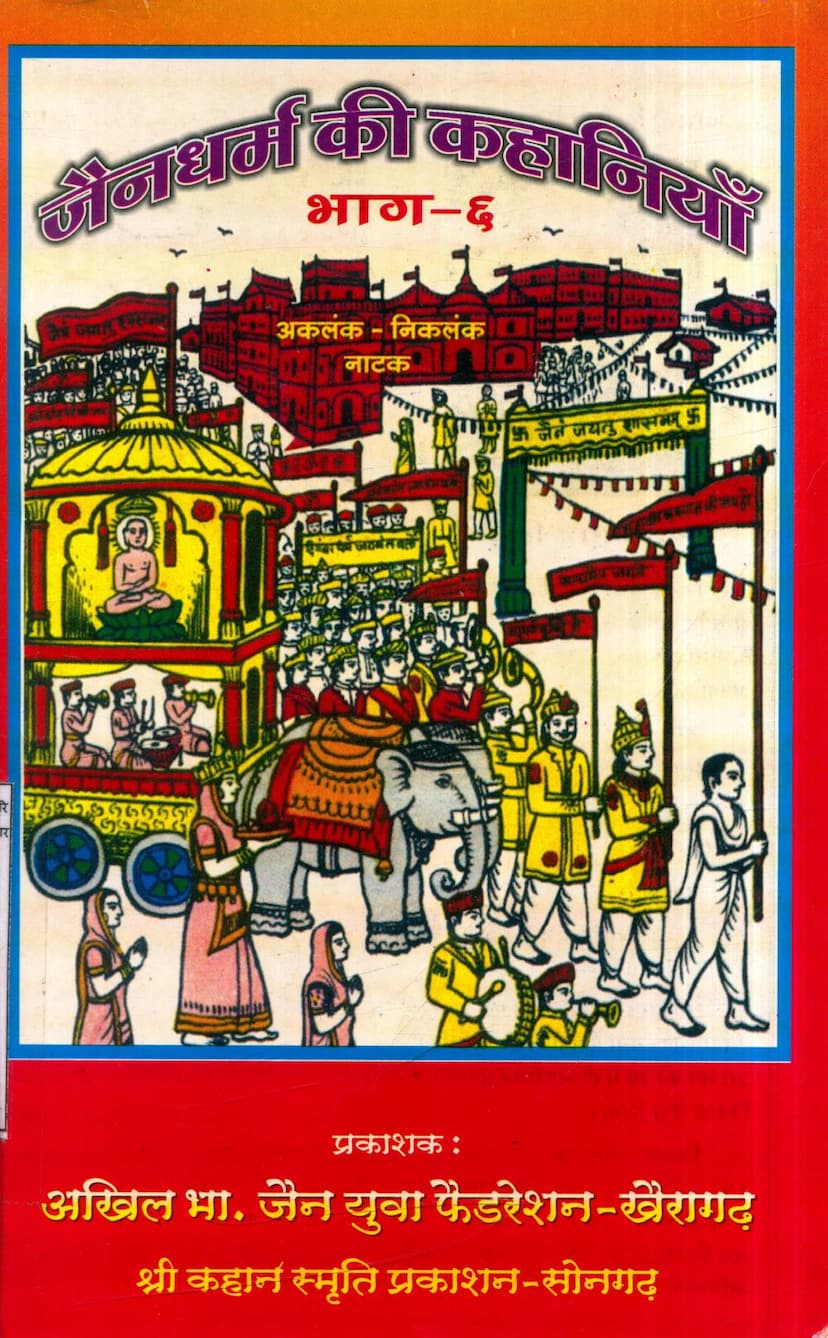Jain Dharm Ki Kahaniya Part 06
Added to library: September 1, 2025

Summary
Here is a comprehensive summary of the Jain text "Jain Dharm Ki Kahaniya Part 06," focusing on the play "Akalank-Nikalank" and related content:
Overall Purpose and Context:
This book, "Jain Dharm Ki Kahaniya Part 06" (Stories of Jainism, Part 06), is part of a series dedicated to propagating Jain religious literature. It is published by the Akhil Bharatiya Jain Yuva Federation and supported by the Shri Kahan Smriti Prakashan. The content is presented as a play titled "Akalank-Nikalank," along with a brief introduction to Acharya Akalank Dev and a separate story titled "Moh Ki Haar." The publication emphasizes its goal of reaching people with the spiritual revolution inspired by Pujya Shri Kanji Swami.
Key Components and Summaries:
-
"Akalank-Nikalank" (Play):
- Theme: This is the central piece of the book, a play depicting the lives and spiritual journey of two brothers, Akalank and Nikalank (originally Akku and Niku in childhood). The play highlights the importance of knowledge, devotion, renunciation, and the courage to defend Jainism.
- Childhood and Early Life: The play begins with Akalank and Nikalank as young boys who, inspired by the teachings of Jain monks (Muni Raj), decide to engage in discussions about the principles of Jainism, such as the meaning of human birth and the path to liberation through Ratnatrayi (right faith, right knowledge, right conduct). They learn about the nine Tattvas (essences) and the importance of distinguishing what is worthy of adoption (Upadheya) from what should be renounced (Heya).
- Renunciation and Dedication: The brothers, along with their father, Purushottam Seth, take a vow of lifelong celibacy during the Dashlakshan festival. This vow is reaffirmed later when they declare their commitment to serving Jainism over worldly pursuits like marriage, despite their father's initial attempts to arrange their weddings.
- Defending Jainism (Encounter with other religions): The play vividly portrays Akalank and Nikalank's dedication to Jainism. They infiltrate a non-Jain (Ekantmat) educational institution to learn their philosophies. There, they discover the teacher's misunderstanding and misrepresentation of Jain principles, particularly the concept of Syadvada (conditional predication).
- The "Syat" Word Incident: Akalank and Nikalank subtly correct a text, adding the crucial word "Syat" to sentences like "Jivah asti, Jivah nasti" (The soul exists, the soul does not exist), transforming it into "Jivah syat asti, Jivah syat nasti" (The soul may exist, the soul may not exist). This addition clarifies the Jain perspective of multiplicity of views for the same object. The teacher, unable to understand the significance of "Syat," is frustrated and attempts to find the culprit.
- The Test of Faith: The teacher devises a test where students must cross an idol of a Jain deity. Akalank and Nikalank, refusing to disrespect their Ishtadev (beloved deity), cleverly place a sacred thread (janeu) on the idol, making it "possessional" (i.e., no longer a pure idol for pure crossing), thus bypassing the dilemma without compromising their faith.
- The Escape and Sacrifice: Discovered through a nighttime test involving shouting during an orchestrated alarm, they are imprisoned. While escaping, Nikalank sacrifices himself to save Akalank, urging him to continue the mission of spreading Jainism.
- The Debate and Victory: The narrative then shifts to Ujjain, where a debate is organized between Jain scholars and proponents of other religions (Ekantmat) to determine whose religious procession will take precedence. Akalank, having survived, arrives and expertly debates with the renowned scholar Sanghshri. Akalank brilliantly defends the Jain philosophy of Anekanta (non-absolutism) and Syadvada, exposing the flaws in the opponent's purely existential or momentary views. Sanghshri, defeated and impressed, not only converts to Jainism but also confesses his role in Nikalank's death. The King and the populace are deeply moved and embrace Jainism, leading to a grand procession and the establishment of Jain influence.
- Overall Message of the Play: The play emphasizes the power of knowledge, unwavering faith, self-sacrifice, and the efficacy of Jain philosophy in resolving disputes and bringing peace and righteousness.
-
"Akalank-Nikalank" (Brief Introduction to Acharya Akalank Dev):
- This section provides a biographical sketch of Acharya Akalank Dev, highlighting his significant contributions to Jain philosophy, particularly in the fields of Dravyanuyoga (theory of substances) and Nyaya (logic and dialectics).
- It places him in the context of Jain tradition, mentioning his mastery of various philosophical schools and his crucial role in preserving and establishing Jainism during times when other religions were dominant.
- It also touches upon the uncertainty surrounding his exact parentage and time period, but firmly establishes his importance as a scholar and defender of Jain dharma.
-
"Moh Ki Haar" (The Defeat of Attachment):
- This is a short, allegorical dialogue between a father and his son. The son, filled with detachment (Vairagya), desires to become a monk and leave home for spiritual practice. The father, attached to worldly comforts and his son, tries to dissuade him. The son, firm in his conviction, explains the ephemeral nature of worldly pleasures and the true joy found in spiritual pursuit, ultimately leading to the father's acceptance and understanding.
Publishing and Dedication:
- The book is dedicated to the memory of Shri Khemaraj Gidia and Shrimati Dhudhibai Gidia, whose blessings and support made the publication series possible.
- It acknowledges the contributions of Pandit Todarmal Smarak Trust and Dr. Hukumchandji Bharill in promoting spiritual teachings.
- The book lists numerous members and donors who have supported the "Shri Kahan Smriti Prakashan" and the "Gramthmalai" (publication series).
Author and Editor:
- Author: Brahmachari Haribhai, Songadh (a disciple of Pujya Shri Kanji Swami who dedicated his life to propagating his teachings).
- Editor: Pandit Rameshchandra Jain Shastri, Jaipur.
Overall Tone and Aim:
The book aims to inspire readers and performers with tales of devotion, intellectual prowess, and steadfast adherence to Jain principles. It seeks to highlight the timeless relevance and strength of Jain philosophy and encourage the propagation of Jain dharma. The stories serve as exemplary narratives for spiritual growth and the defense of one's faith.